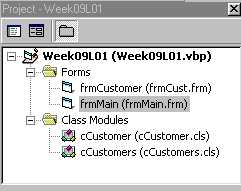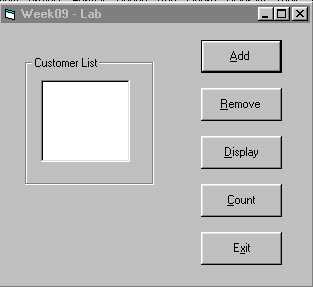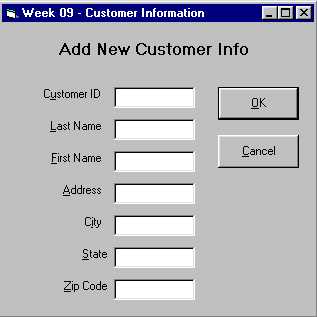Lab for Week 10 - Step by Step
Very Busy (VB) Mail Order
Collections and Customer Information
This example will gather information from the user and store it in a Collection.
 |
Perhaps the most important feature of this lab is the heirarchy or
relationship between the components. frmMain ONLY talks to frmCustomer
frmCustomer ONLY has knowledge of cCustomers (the Collection)
cCustomers ONLY works with cCustomer (the Member Class)
It is true that frmCustomer needs SOME knowledge of what goes into the Collection, but
there is no direct connection between the two components.
|
The interface looks like this:
Here is the working example
The Main Form uses the services of the Customer Form and maintains its own user
interface. The coding in frmMain is almost trivial.
Private Sub cmdAdd_Click()
With frmCustomer
.Action = "A"
.Show vbModal
End With
lstCustomer.ListIndex = -1
End SubPrivate Sub cmdCount_Click()
MsgBox "There are " & _
frmCustomer.CustCount & _
" customers."
End Sub
|
Private Sub cmdDisplay_Click()
If lstCustomer.ListIndex <> -1 Then
With frmCustomer
.cmdCancel.Visible =
False
.Key =
lstCustomer.List(lstCustomer.ListIndex)
.Action = "D"
.Show vbModal
End With
lstCustomer.ListIndex = -1
frmCustomer.cmdCancel.Visible = True
Else
MsgBox "Please Select a Customer from the
List", _
vbOKOnly, "Input Requested"
End IfEnd Sub |
Private Sub cmdRemove_Click()
If lstCustomer.ListIndex <> -1 Then
With frmCustomer
.Key =
lstCustomer.List(lstCustomer.ListIndex)
.Action = "R"
.Show vbModal
End With
lstCustomer.ListIndex = -1
Else
MsgBox "Please Select a Customer from the
List", _
vbOKOnly, "Input Requested"
End If
End Sub
The Customer Form contains three Form Properties and calls on the Collection Class
services to Add to the Collection, Remove from the Collection, and Display an entry in the
Collection. One of the properties queries for the Collection Count.As was mentioned
previously, the separation in the responsibilities of each of the components is important
and should be re-emphasized.
Private Sub DisplayData()
With m_Customers(m_strKey)
txtID.Text = .CustomerID
txtLastName.Text = .LastName
txtFirstName.Text = .FirstName
txtAddress.Text = .Address
txtCity.Text = .City
txtState.Text = .State
txtZipCode.Text = .ZipCode
End With
End Sub |
This code appears to consist of simple assignment statements
(and that's what it is supposed to look like). The reference to a particular element in
the Collection returns a member object and the following assignments call the Member Class
Property Get Procedures This will look particularly confusing when running under the
debugger. It is often asked why this is not coded directly into the Customer Form, and the
response is always that the design must support the separation of the components.
It's a design specification |
The Collection Class must support the Add and Remove Methods, and the Item and Count
Properties.
The Add looks complex, but each assignment calls the Porperty Set Procedures for the
Member Class. Each of these procedures do nothing more than use the services of the
Collection object that is built into Visual Basic.
Public Sub Add(ByVal strCustomerId As String, _
ByVal strLastName As String, _
ByVal strFirstName As String, _
ByVal strAddress As String, _
ByVal strCity As String, _
ByVal strState As String, _
ByVal strZipCode As String)
' Create the Customer that will be
' Added to the Customers Collection
Dim NewCustomer As New cCustomer
' Each assignment will call the
' Property Let procedure in cCustomer
' as a reference is being made to NewCustomer
With NewCustomer
.CustomerID = strCustomerId
.LastName = strLastName
.FirstName = strFirstName
.Address = strAddress
.City = strCity
.State = strState
.ZipCode = strZipCode
' Add it to the Collection
' Reference to .CustomerID is a call to
' the Property Get procedure
m_Customers.Add NewCustomer, .CustomerID
End With
End Sub
Public Sub Remove(ByVal strKey As String)
m_Customers.Remove strKey
End Sub
Public Function Item(ByVal strKey As String) As cCustomer
Set Item = m_Customers.Item(strKey)
End Function
Public Property Get Count() As Long
Count = m_Customers.Count
End Property
And finally, the Member Class is required only to provide Property Let and Property Set
Procedures for each of the properties that the class exposes.
Private m_strCustomerID As String
Private m_strLastName As String
Private m_strFirstName As String
Private m_strAddress As String
Private m_strCity As String
Private m_strState As String
Private m_strZipCode As String
Understanding the layers at work here is the most important part of this lab. The
project appears to be complex on the surface, but like many problems, breaking it down
into components will make the design, coding, and support much easier.
This completes the lab
Back to Week 10


